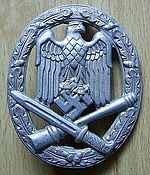General Assault Badge
| General Assault Badge Allgemeines Sturmabzeichen | |
|---|---|
 design by Wilhelm Ernst Peekhaus | |
| Type | Badge |
| Eligibility | Military personnel |
| Campaign(s) | World War II |
| Status | Obsolete |
| Established | 1 June 1940 |
 . .A Wehrmacht non-commissioned officer wearing the General Assault Badge. | |
The General Assault Badge (German: Allgemeines Sturmabzeichen) was a military decoration awarded during World War II to personnel of the German Army, Waffen-SS and Ordnungspolizei (order police) who supported an infantry attack but were not part of specific infantry units and therefore did not qualify for the Infantry Assault Badge. It was instituted by General Walther von Brauchitsch on 1 June 1940.[1]
Design
The decoration, designed by the Berlin-based firm of Wilhelm Ernst Peekhaus, was an oval disk that measured 5.3 cm (2 in) by 4.2 cm (2 in) by .6 cm (0 in) wide. A wreath of five oak leaves runs around the circumference on each side of the medal with a pair of acorns at the base. Inside the wreath is a large Wehrmacht-style eagle with folded wings grasping a swastika which itself surmounts a crossed bayonet and stick grenade. The medal was held in place on the uniform with a pin and catch.[2]
From 22 June 1943, the medal was adapted with a small plate at the base with either 25, 50, 75 or 100 to recognise those soldiers that had taken part in numerous attacks. These were known as grades II through V, accordingly. On the Class IV and Class V badges the oak leaves which run around the circumference on each side of the medal, along with the bayonet and hand grenade, were larger in size. Further the wreath was gold in color.[2]
Criteria for award
The medal was originally designed for presentation to combat engineers, as well as members of the artillery, anti-aircraft and anti-tank who supported infantry units in combat. It could also be awarded to medical personnel attending to battlefield casualties in "close combat conditions".[1] Prior to the introduction of the Tank Destruction Badge, the General Assault Badge could be conferred for the single-handed destruction of tanks or armoured vehicles.[3]
Other determining factors for award:[1]
- Ineligibility for the Infantry Assault Badge
- Participation in three infantry or armored attacks on three different days; or
- Participation in three infantry or armored indirect assaults on three different days.
Notes
- ^ a b c Angolia 1987, p. 92.
- ^ a b Angolia 1987, pp. 92–93.
- ^ Angolia 1987, p. 96.
References
- Angolia, John (1987). For Führer and Fatherland: Military Awards of the Third Reich. R. James Bender Publishing. ISBN 0912138149.
{{cite book}}: Invalid|ref=harv(help)
